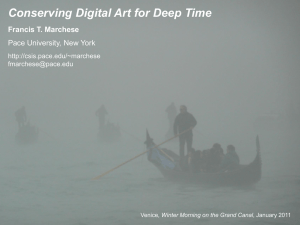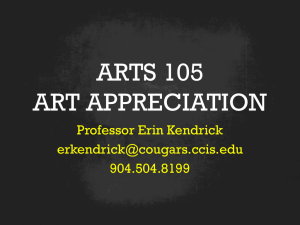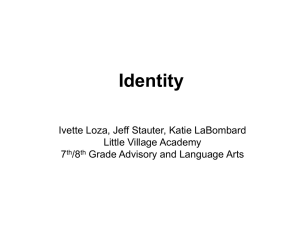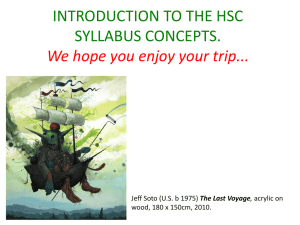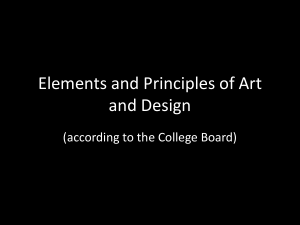The Four Steps of Formal Analysis
advertisement
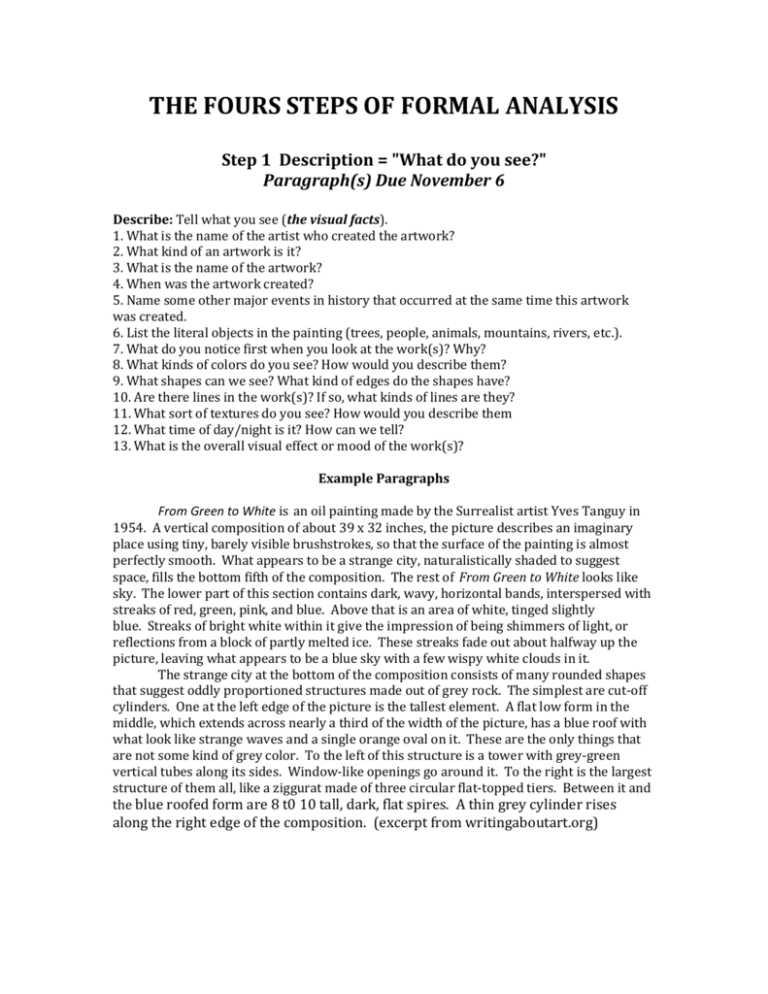
THE FOURS STEPS OF FORMAL ANALYSIS Step 1 Description = "What do you see?" Paragraph(s) Due November 6 Describe: Tell what you see (the visual facts). 1. What is the name of the artist who created the artwork? 2. What kind of an artwork is it? 3. What is the name of the artwork? 4. When was the artwork created? 5. Name some other major events in history that occurred at the same time this artwork was created. 6. List the literal objects in the painting (trees, people, animals, mountains, rivers, etc.). 7. What do you notice first when you look at the work(s)? Why? 8. What kinds of colors do you see? How would you describe them? 9. What shapes can we see? What kind of edges do the shapes have? 10. Are there lines in the work(s)? If so, what kinds of lines are they? 11. What sort of textures do you see? How would you describe them 12. What time of day/night is it? How can we tell? 13. What is the overall visual effect or mood of the work(s)? Example Paragraphs From Green to White is an oil painting made by the Surrealist artist Yves Tanguy in 1954. A vertical composition of about 39 x 32 inches, the picture describes an imaginary place using tiny, barely visible brushstrokes, so that the surface of the painting is almost perfectly smooth. What appears to be a strange city, naturalistically shaded to suggest space, fills the bottom fifth of the composition. The rest of From Green to White looks like sky. The lower part of this section contains dark, wavy, horizontal bands, interspersed with streaks of red, green, pink, and blue. Above that is an area of white, tinged slightly blue. Streaks of bright white within it give the impression of being shimmers of light, or reflections from a block of partly melted ice. These streaks fade out about halfway up the picture, leaving what appears to be a blue sky with a few wispy white clouds in it. The strange city at the bottom of the composition consists of many rounded shapes that suggest oddly proportioned structures made out of grey rock. The simplest are cut-off cylinders. One at the left edge of the picture is the tallest element. A flat low form in the middle, which extends across nearly a third of the width of the picture, has a blue roof with what look like strange waves and a single orange oval on it. These are the only things that are not some kind of grey color. To the left of this structure is a tower with grey-green vertical tubes along its sides. Window-like openings go around it. To the right is the largest structure of them all, like a ziggurat made of three circular flat-topped tiers. Between it and the blue roofed form are 8 t0 10 tall, dark, flat spires. A thin grey cylinder rises along the right edge of the composition. (excerpt from writingaboutart.org) Step 2 Analysis = How is the work arranged? Paragraphs Due November 15th Analyze: This section should be the largest portion of your paper. Take the elements and principles and elaborate on how the artist used them in their work of art. Mentally separate the parts or elements, thinking in terms of textures, shapes/forms, light/dark or bright/dull colors, types of lines, and sensory qualities. In this step consider the most significant art principles that were used in the artwork. Describe how the artist used them to organize the elements. Suggested questions to help with analysis: 1. How has the artist used colors in the work(s)? 2. What sort of effect do the colors have on the artwork? 3. How as the artist used shapes within the work of art? 4. How have lines been used in the work(s)? Has the artist used them as an important or dominant part of the work, or do they play a different roll? 5. What role does texture play in the work(s)? Has the artist used the illusion of texture or has the artist used actual texture? How has texture been used within the work(s). 6. How has the artist used light in the work(s)? Is there the illusion of a scene with lights and shadows, or does the artist use light and dark values in a more abstracted way? 7. How has the overall visual effect or mood of the work(s)? been achieved by the use of elements of art and principles of design. 8. How were the artists design tools used to achieve a particular look or focus? FORMAL ANALYSIS STEP 3 AND 4: INTERPRETATION AND JUDGEMENT Interpretation: An interpretation seeks to explain the meaning of the work based on what you have learned so far about the artwork, what do you think the artist was trying to say? 1. What was the artist’s statement and/or title in this work? 2. What do you think it means? 3. What does it mean to you? 4. How does this relate to you and your life? 5. What feelings do you have when looking at this artwork? 6. Do you think there are things in the artwork that represent other things-­­ symbols? 7. Why do you think that the artist chose to work in this manner and made these kinds of artistic decisions? 8. Why did the artist create this artwork? Judgment: After careful observation, analysis, and interpretation of an artwork, you are ready to make your own judgment. This is your personal evaluation based on the understandings of the work(s). Here are questions you might consider: 1. Why do you think that this work has intrinsic value or worth? What is the value that you find in the work(s)? (For example, it is a beautiful work of art, conveys an important social message, affects the way that I see the world, makes insightful connections, reaffirms a religious belief, etc.) 2. Do you think that the work(s) has a benefit for others? Do you find that the work communicates an idea, feeling or principle that would have value for others? 3. What kind of an effect do you think the work could have for others? 4. Does the work lack value or worth? Why do you think this is so? Could the reason you find the work lacking come from a poor use of the elements of art? Could the subject matter by unappealing, unimaginative, or repulsive? 5. Rather than seeing the work as being very effective or without total value, does the work fall somewhere in-­­between? Do you think that the work is just o.k.? What do you base this opinion on? The use of elements of art? Lack of personal expression? The work lacks a major focus? Explore your criticism of the work (s) as much as you would any positive perceptions. Realize that your own tastes and prejudices may enter into your criticism. Give your positive and negative perceptions. 6. What standards are you using to judge this artwork? Some standards are derived from traditional theories of art: Mimetic: art is an imitation of the world; Expressionistic: art is an expression of an emotion; Pragmatic: art functions toward some practical end; Formal: art is a significant arrangement of sensory elements.

